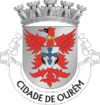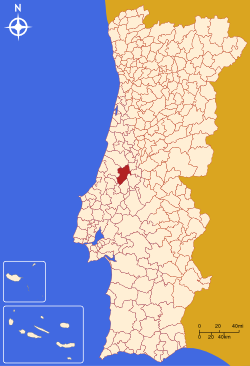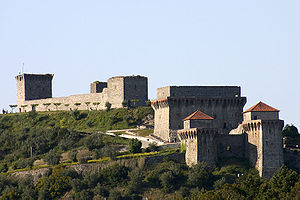- Ourém Municipality
-
Ourém — Municipality — 
Flag
Coat of armsLocation in Portugal Coordinates: 39°39′N 8°34′W / 39.65°N 8.567°WCoordinates: 39°39′N 8°34′W / 39.65°N 8.567°W Country  Portugal
PortugalRegion Centro Subregion Médio Tejo District/A.R. Santarém Government – Mayor Paulo Fonseca[1] (PS) Area – Total 416.6 km2 (160.9 sq mi) Population – Total 49,269 – Density 118/km2 (305.6/sq mi) Parishes (no.) 18 Municipal holiday
June 20Website http://www.cm-ourem.pt Ourém (Portuguese pronunciation: [owˈɾɐ̃j]) is a municipality in Portugal with a total area of 416.6 km² and a total population of 49,269 inhabitants. The city itself has a population of about 12,000. The municipality is composed of 18 parishes, and is located in the district of Santarém. The municipality is bordered by the municipalities of Pombal (to the north), Alvaiázere (to the northeast), Ferreira do Zêzere and Tomar (to the east), Torres Novas (to the southeast), Alcanena (to the southwest), and Batalha and Leiria (to the west). The municipality of Ourém has two cities : Ourém (about 12,000 residents) and Fátima (about 11,000 inhabitants). The main historical attraction of the municipality is the mighty Castle of Ourém. Nevertheless, millions of faithful Catholics come to the parish of Fátima every year to visit the site where three child shepherds had visions of Our Lady of Fátima in 1917.
The present Mayor is Paulo Fonseca, elected by the Socialist Party[2].
The municipal holiday is June 20.
Contents
History
A fortification existed in the region of Ourém since at least the period of Muslim domination. The area was reconquered by Christians in 1136, and the town was donated in 1178 by the first king of Portugal, Afonso Henriques, to his third daughter, Princess Theresa. The princess granted it a letter of feudal rights (foral) in 1180, to promote the settlement and development of the village.
Under the Muslims, the village was apparently called Abdegas, but during the times of the Reconquista (12th century) it was called Portus de Auren, from which the name Ourém was later derived. According to popular myth, the name of the village is actually derived from a Moorish Princess who converted to Christianity under the name of Oureana.
The town's historical nucleus developed around the Castle of Ourém, which during the Reconquista served as watchpost for the Castle of Leiria, an important stronghold located nearby. In the mid-14th century, King Peter I turned Ourém and its lands into a County. The third Count of Ourém was the celebrated Nuno Álvares Pereira, the knight who led the Portuguese army to victory against the Castilians in the Battle of Aljubarrota in 1385.
Under Count Afonso (1402–1460), fourth Count of Ourém, the town flourished. To accommodate his court, Count Afonso remodelled the old-fashioned castle and built a palace inside it following the trends in 15th-century Italian military architecture. The ruins of the palace and castle are the main historical and touristic attraction of the town nowadays. Count Afonso is buried in the crypt of the main church of Ourém in a magnificent Gothic tomb created by one of Portugal's main sculptors of the time, Diogo Pires-o-Velho.
After reaching its peak in the 15th century, the town entered a period of relative decadence. The town and castle were greatly damaged by the 1755 Lisbon earthquake and the Napoleonic Invasions.
Until its elevation to the status of a city on August 16, 1991, Ourém was known as Vila Nova de Ourém.
Legend
The legend of the name of the village and Oureana is retold by Friar Bernardino de Brito in his Chronicle of the Order of Cister (1602): In a surprise attack on the St John's Day in 1158, a Christian knight, Gonçalo Hermigues and his companions kidnapped a Moorish princess with the famous Arab name of Fatima. The knight took Fatima to a small village of the recently-created Kingdom of Portugal, in the Serra de Aire hills. The princess fell in love with the Christian knight and decided to become herself a Christian, taking the name of Oureana. They got married and the princess received as prize the town which she called Ourém, after her name.
The name of the parish of Fátima of Ourém is probably related to this legend.
Parishes
- Alburitel
- Atouguia
- Casal dos Bernardos
- Caxarias
- Cercal
- Espite
- Fátima
- Formigais
- Freixianda
- Gondemaria
- Matas
- Nossa Senhora da Piedade (Ourém)
- Nossa Senhora das Misericórdias (or Nossa Senhora da Misericórdia, formerly Nossa Senhora da Visitação) (Ourém)
- Olival
- Ribeira do Fárrio
- Rio de Couros
- Seiça
- Urqueira
Population
Population of Ourém municipality (1801–2004) 1801 1849 1900 1930 1960 1981 1991 2001 2004 12,803 13,033 25,726 34,534 47,511 41,376 40,185 46,216 49,269 References
External links
- Municipality official website
- Ourém in the Leiria-Fátima Tourism website, in English
- O Castelo, blog about Ourém
- AUREN - Por Ourém e pelos oureenses!
Abrantes · Alcanena · Almeirim · Alpiarça · Benavente · Cartaxo · Chamusca · Constância · Coruche · Entroncamento · Ferreira do Zêzere
Golegã · Mação · Ourém · Rio Maior · Salvaterra de Magos · Santarém · Sardoal · Tomar · Torres Novas · Vila Nova da Barquinha Categories:
Categories:- Cities in Portugal
- Municipalities of Portugal
Wikimedia Foundation. 2010.


